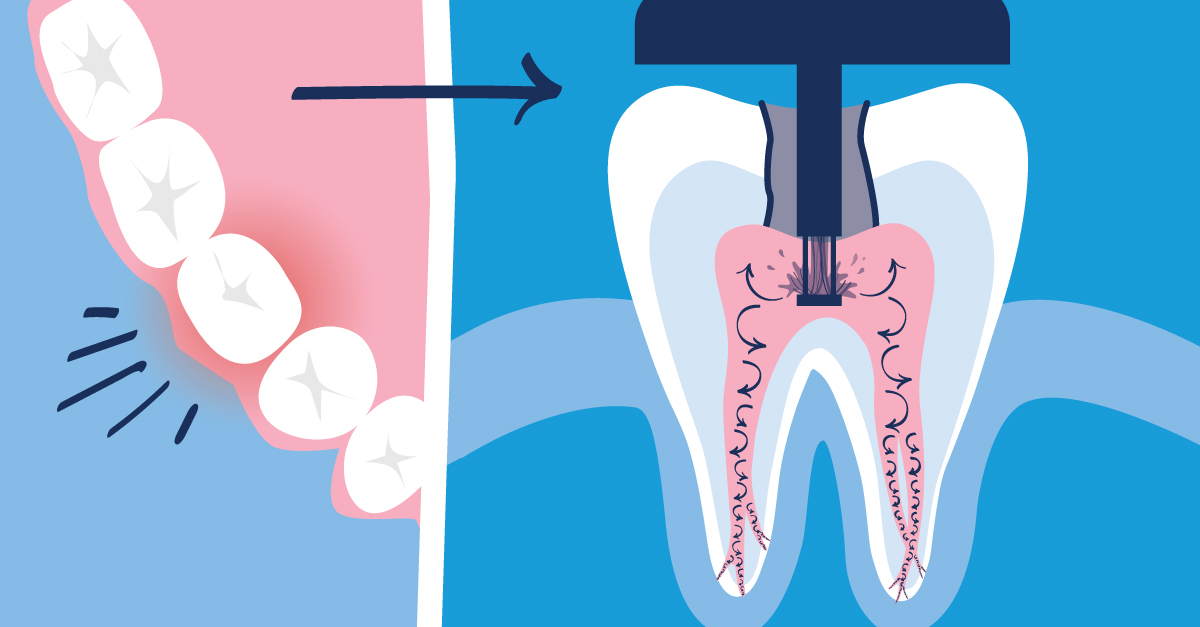Inside your tooth, under the white enamel and dentin, there’s a soft tissue called the pulp.* Within this pulp, there are blood vessels, nerves and connective tissue—and if this area becomes infected or inflamed, an endodontic treatment is needed.*
Read on to discover more about what your root canal treatment options are, as well as what you can expect before, during and after treatment!
Diagnosing an Infected Root Canal System
There are various signs of an infected root canal system, including pain, prolonged sensitivity to heat or cold, tenderness to the touch and chewing, discoloration of the tooth and swelling.* If you’re experiencing these symptoms, be sure to schedule an appointment with your dentist right away—delaying treatment can lead to an abscess tooth.*
During your initial appointment, your dentist might take X-rays if a root canal system infection is suspected.** If your dentist confirms this diagnosis, he or she may either perform the root canal therapy themselves—or refer you to an endodontist.
Types of Root Canal Procedures
Root canal procedures are intended to remove the inflamed and infected pulp from the tooth.* If the canals within the root canal system are not thoroughly cleaned and disinfected, they may become infected again during your root canal recovery, which can then require root canal retreatment. ***

There are several types of root canal procedures that have differing protocols and success rates. Our primary focus, though, will be on comparing standard root canal treatment with the GentleWave® Procedure.
What Happens During the Root Canal Procedure
The exact process of your root canal treatment will differ depending on your specific condition, as well as the method of root canal therapy you choose.
Anesthesia Before the Procedure
Local anesthesia is typically used in preparation of a root canal procedure,† and your dentist or endodontist will numb the area near the tooth to make you more relaxed and at ease.†
Removing the Infected Pulp
While standard root canal treatment is widely practiced, advancements over the years have only been incremental. †† Standard root canal treatment uses files to create the access cavity into the tooth, and the files are then used to manually clear the canals of the infected pulp, bacteria and debris.† Because of the complexities and hard-to-reach areas in the root canal anatomy, standard root canal treatment can leave behind infected tissue2 that can lead to reinfection.
Patients looking for an effective alternative to standard root canal treatment can opt for the GentleWave® Procedure. This root canal procedure is minimally invasive1 and utilizes broad-spectrum acoustic energy to clean and disinfect the root canal system, 1,2 reaching into the microscopic spaces1,2 that standard root canal treatments often cannot3. The result? Efficient cleaning of the root canal system1 that offers the chance for improved outcomes4 and fast healing4, plus preservation of the dentin of the tooth4.
Length of the Root Canal Process
How long a root canal procedure takes depends on the treatment option you choose. For standard root canal treatment, you can expect one or two appointments at about 90 minutes each.** In comparison, the GentleWave Procedure can typically be completed in just one session.4
Root Canal Recovery
If you’re experiencing any mild discomfort during recovery, patients can manage it by taking an over-the-counter pain medication.† It’s important that patients avoid chewing on the tooth until all of the tenderness is gone, as this will help avoid recontamination of the interior of the tooth.†
Choosing Your Root Canal Provider
Are you interested in a revolutionary root canal treatment option that can help save your natural tooth? Use our Provider Locator to find a GentleWave Provider in your area today!
* AAE
** MedicineNet
***AAE
† WebMD